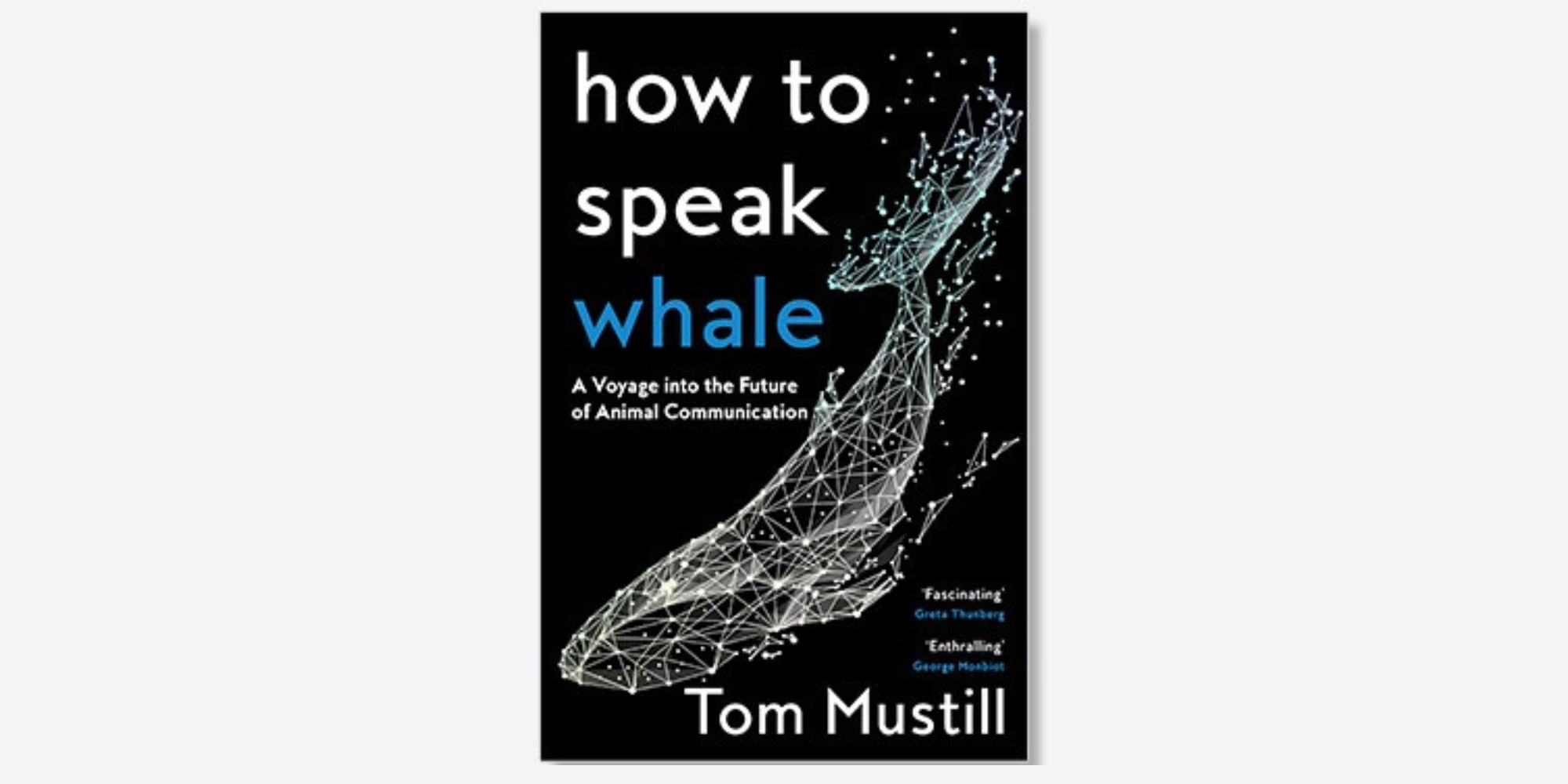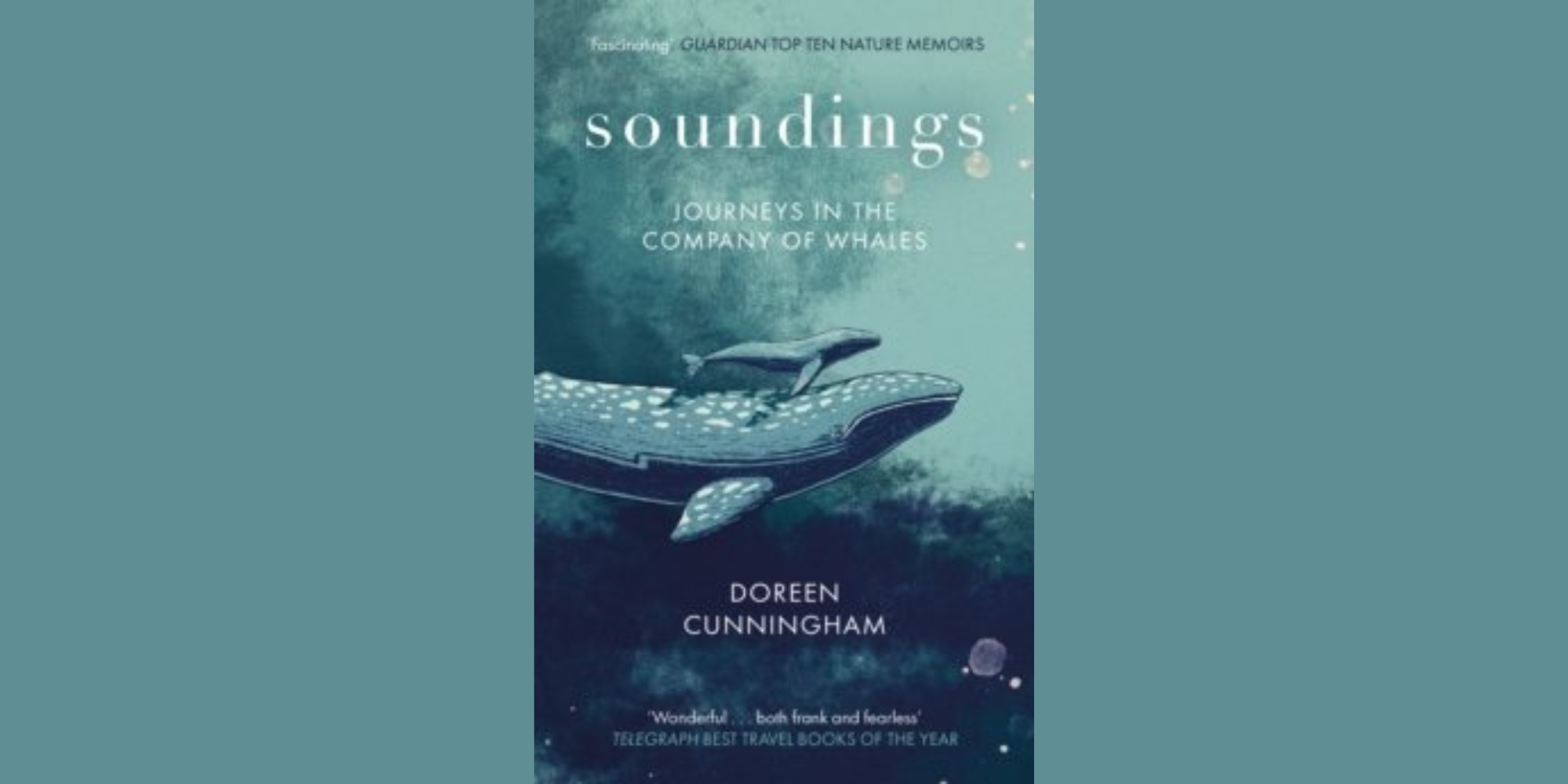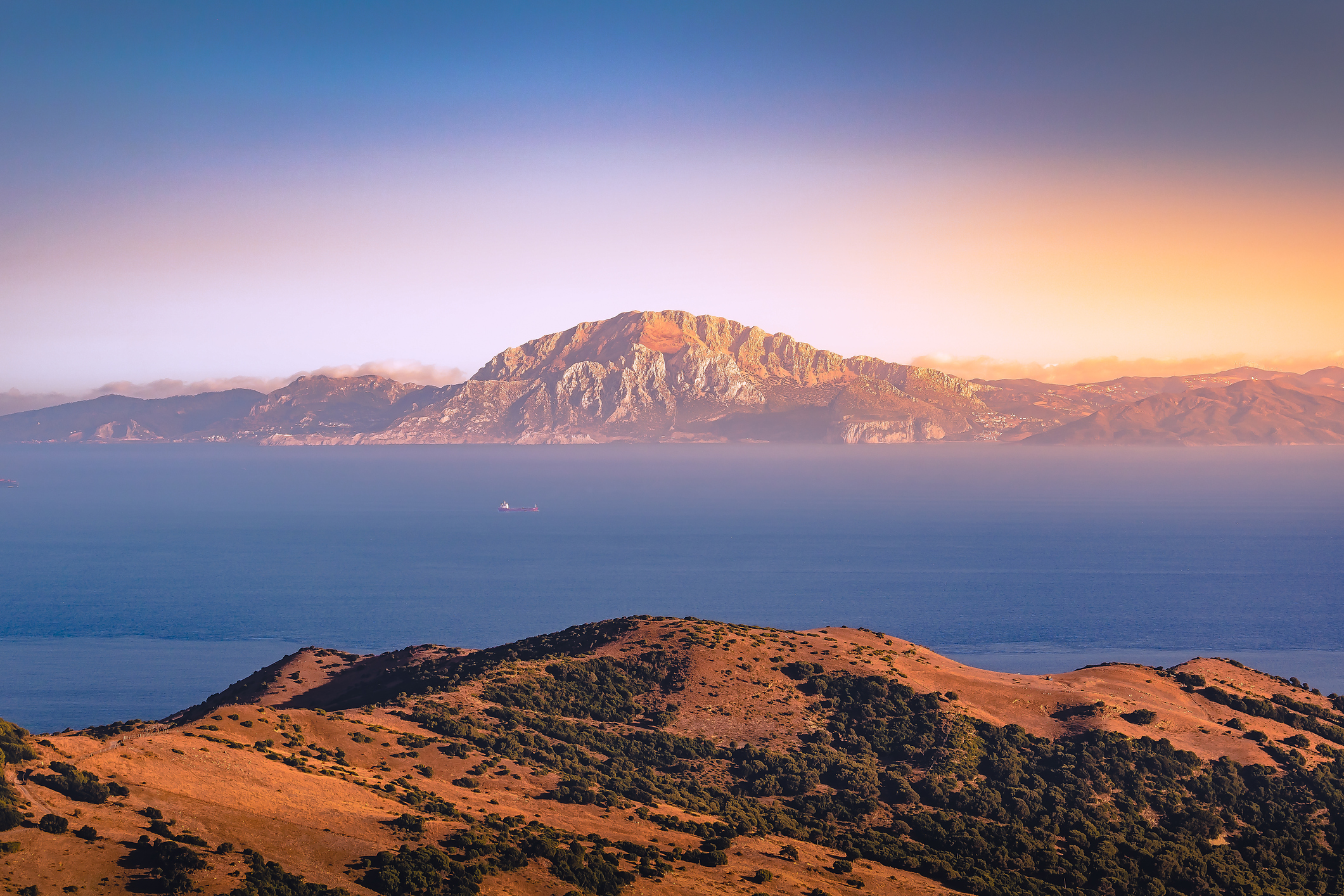Is there more than one species of orca on the Pacific coast?
Recent research has shed new light on killer whales’ genetic and behavioural diversity along the Pacific coast of North America. In particular, “Resident” and “Bigg’s” killer whales (after Canadian scientist Michael Bigg, sometimes referred to as “Transients”), previously considered distinct ecotypes within a species, may soon be recognised as distinct subspecies or even separate species.
These findings come from the research of Phillip Morin and colleagues, who addressed genetic differences and millennia-old evolutionary trends and distinguished the two groups in their behaviour, diet, and social structures.
Differences in behaviour, genetics, and ecology
As early as the 1970s, Michael Bigg observed that although Resident and Transient Orcas often inhabited the same coastal waters, they did not mate or interact with each other. These findings led to the classification of Southern Resident Orcas as a distinct population segment, which granted them protection under the Endangered Species Act in 2005.
Recent genetic, physical, and behavioural research sponsored by NOAA and other institutions now confirms that the two ecotypes may, in fact, be distinct species.
The Resident Orcas are characterised by their preference for fish, especially salmon, and their distinct social structure. These animals live in close and stable family groups, known as pods, and frequently interact with each other.

Source: Morin et al. (2024), showing a top view on Bigg’s Orcas (left) and Resident Orcas (right)
Their communicative behaviour, consisting of squeaks, calls, and whistles, is also very pronounced. In contrast, “Bigg’s” Orcas specialise in hunting marine mammals, including seals and smaller whales. This group hunts in smaller, more flexible groups to catch their prey more efficiently and primarily uses non-verbal communication to avoid drawing their prey’s attention to them.
These differences in hunting behavior and social structure are not just superficial adaptations but are deeply rooted in the DNA of the two groups. Genetic analyses have shown that these ecotypes have developed separately for over 300,000 years, indicating significant evolutionary differences.
Nevertheless, for a long time, they were only considered different ecotypes or unnamed subspecies of the Orcinus Orca. In their work, Phillip Morin and his team now concluded that the two groups should be listed as separate species in the future.
In accordance with their claim, the taxonomy committee of the Society for Marine Mammalogy included these latest findings in its annual report at the beginning of September 2024 and declared that although they do not yet consider the Resident and Transient Orca groups of the Pacific coast to be independent species, they nevertheless nominate them for the status of a subspecies of Orcinus Orca:
“The Taxonomy Committee completed its annual review of the official Society for Marine Mammalogy list of marine mammal species and subspecies for 2024. […] The updated list also includes the addition of three killer whale subspecies: Orcinus orca ater (resident killer whale) and O. orca rectipinnus (Bigg’s killer whale), with O. orca orca (common killer whale) as the nominate subspecies. Resident and Bigg’s killer whales have been recognised in the past as un-named subspecies, and were listed in previous versions of the list […].” (Society for Marine Mammalogy, 9 September 2024)
Scientific controversies and future of orca species research
Despite the extensive genetic differences, the scientific community is still reluctant to classify the orcas as separate species. The annual report of the Society for Marine Mammalogy’s Taxonomy Committee (2024) emphasised that killer whale taxonomy remains a subject of intense research:
“Although Morin et al. (2024) proposed their recognition as distinct species of killer whales, such proposal was not followed by the Taxonomy Committee because there were concerns whether this represents a species- or subspecies-level designation. The reasons were mainly due to (1) a possible episodic gene flow among the ecotypes, and (2) the need to conduct a more comprehensive comparative analysis on a global scale to better understand how distinct these ecotypes are from other Orcinus orca clades.
“Therefore, pending further investigation to better evaluate the taxonomy of the eastern North Pacific killer whales, the two ecotypes are considered provisionally as distinct subspecies of Orcinus orca and named following Morin et al. (2024).” (Society for Marine Mammalogy, 9 September 2024)
Efforts are underway to adapt the classification as soon as there is sufficient evidence to distinguish the species clearly. Still, these developments suggest that other undiscovered ecotypes exist in different oceans, which could be classified as separate subspecies and, in the best case, as separate species. This, in turn, would make a significant contribution to preserving biodiversity in the oceans.

Source: NOAA Fisheries, Credit: Merlin Smith
Significance for species conservation
The formal species distinction between the ecotypes of orcas has far-reaching consequences for nature conservation. Each group plays a unique role in its ecosystem: while the Residents help regulate fish populations, the Bigg’s killer whales contribute to controlling marine mammal populations.
Overfishing and habitat loss are a particular threat to the Resident Orcas, which depend on stable salmon stocks in the Pacific. Elsewhere in Spain, Resident Orcas depend on tuna populations. Recognising these groups, possibly even as separate species, could lead to more specific conservation measures tailored to the needs of each group.
Conclusion
Realising that the “Resident” and “Bigg’s” killer whales can be considered distinct subspecies or species represents a significant advance in marine biology and conservation. The differentiation emphasizes the remarkable diversity within killer whales and underscores the urgency of improving their protection.
In addition to the orcas of the Pacific coast, this type of research could also be applied to the Iberian Orcas living in the Atlantic. Like the Pacific Residents, the Iberian Orcas also show specialised and communicative social and hunting behavior.
If future genetic studies reveal a similar differentiation from other orca groups in the Atlantic, it could lead to a reassessment of the conservation status of the Iberian Orcas, which the remaining 35 individuals would urgently need. Until then, it is crucial to protect the habitats and food sources of these unique marine mammals.
How to Speak Whale: A Voyage into the Future of Animal Communication
“Either we continue to imagine and project onto them all sorts of things about the inner worlds and communication of whales and other species, or we make the effort to find out what is really there. This is critically important because the capacity for language is one of the last absolute bastions of human uniqueness, one of the few feats we believe only humans are capable of. […] Whales are the lynchpin of our ecosystem. […] [and] our human uniqueness has already cost us dearly.” Tom Mustill, How to Speak Whale: A Voyage into the Future of Animal Communication.
In September 2015, Tom Mustill and his friend Charlotte experienced something extraordinary while kayaking in California’s Monterey Bay, one of the most popular spots for whale watching.
As the two were turning back to shore, a large humpback whale suddenly appeared right next to them and crashed into their kayak – a scene that was filmed and photographed by several people and can still be found on the Internet today.
The “prime suspect,” as Mustill later dubbed it, or CRC-12564 on Ted Cheeseman’s Happywhale Project website, narrowly missed them but scraped the kayak as it fell, trapping Mustill and his friend under the water.
Miraculously, both survived without major physical injury. A befriended professor of Mustill’s, Joy Reidenberg, later surmised that the whale had deviated from its original leaping path, perhaps to avoid hitting the pair directly.
Nevertheless, that day was a life-changing event for Mustill and one of the main reasons for his book, How to Speak Whale: A Voyage into the Future of Animal Communication.
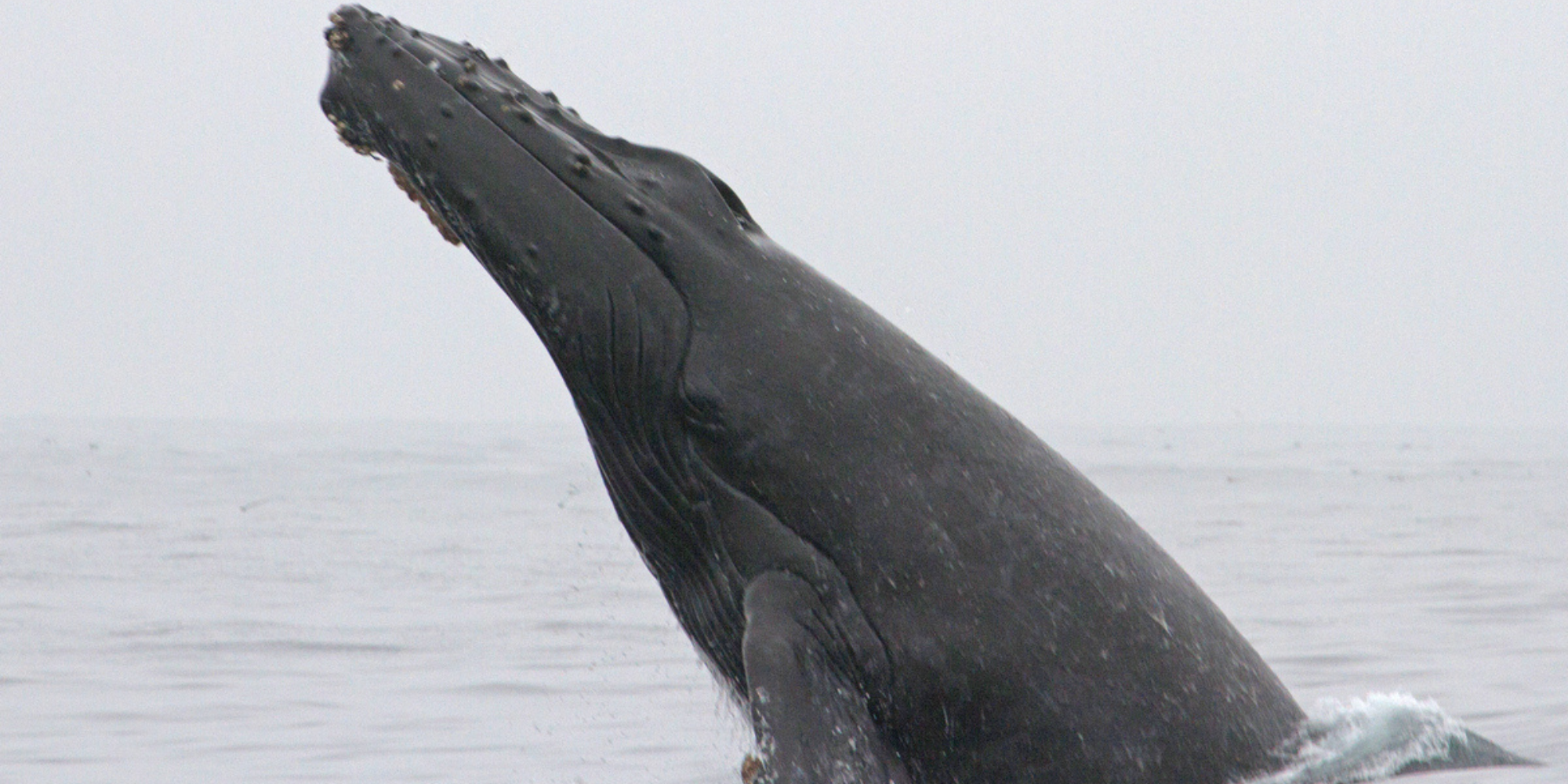
“Prime Suspect” as pictured on the Happywhale Project website. Photo credit: Kate Spencer
In the book, Mustill takes us through years of knowledge gaining about whales and dolphins since the 2015 incident, meeting research legends like Dr. Roger Payne (and many, many, many more amazing people), who was one of the first to research the songs of humpback whales and made them available to the public in the 1970s.
His campaign to protect and conserve humpback whales through their extraordinary songs sparked worldwide conservation movements and put pressure on governments, including the U.S., which passed the Marine Mammal Protection Act in 1972.
Whale songs also became part of the content of the 1971 Voyager spacecraft, which were designed, among other things, to carry messages or expressions of life from Earth into space.
Payne and his colleague Scott McVay analysed the songs of humpback whales and concluded that they were not just single notes, but that certain sequences of notes were repeated, forming entire themes.
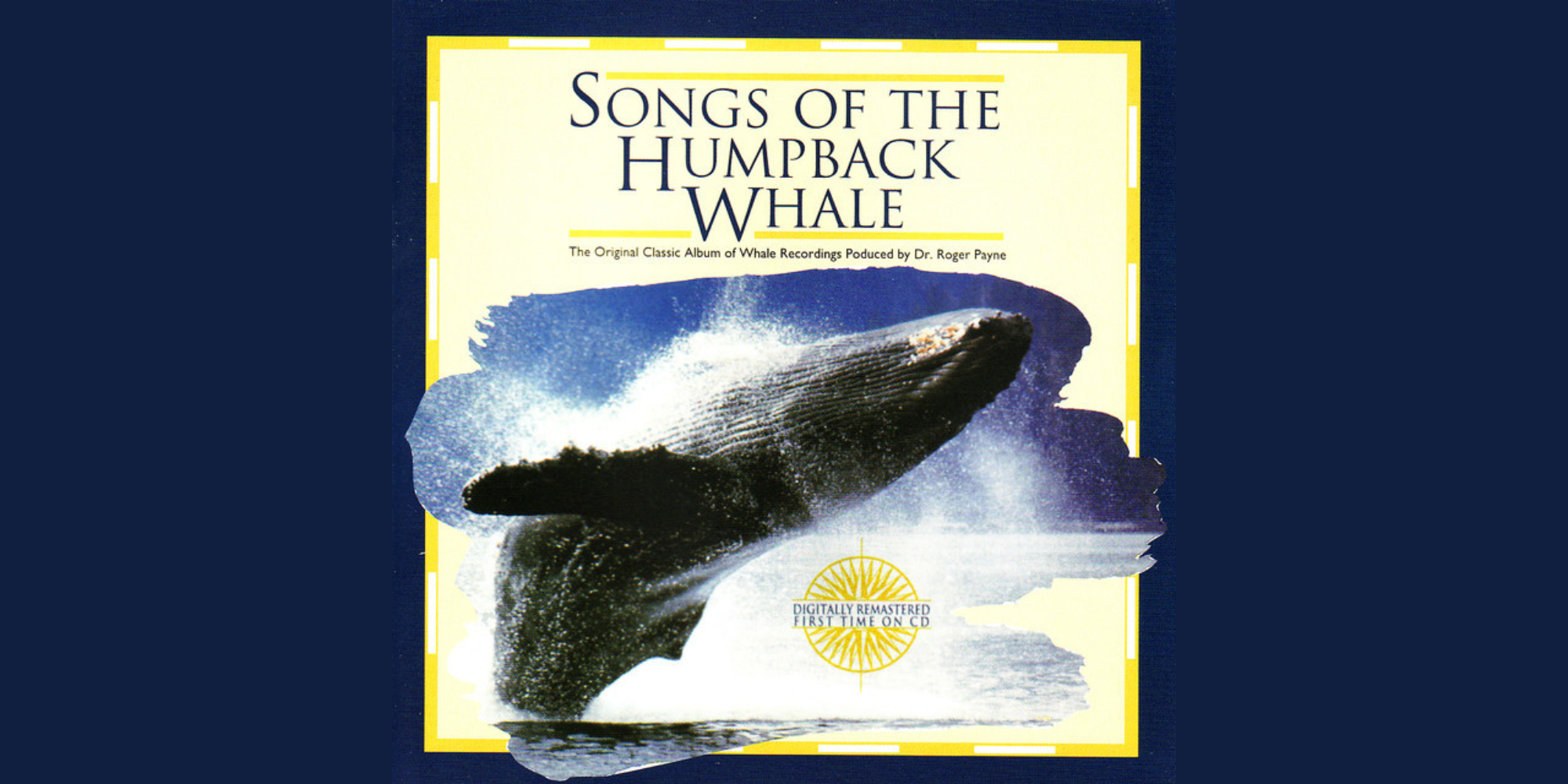
In addition to Dr. Payne, Mustill also interviewed Joy Reidenberg, whom he joined in dissecting stranded whales and, together with her colleague Patrick Hof, she analyses cetacean brains at Mount Sinai Hospital in order to draw at least partial conclusions about their cognitive abilities.
In this context, Mustill also addresses the difficulties in the discussion about “cognitive intelligence” and thus also about “language”. He reports on the research of Dr. Diana Reiss with dolphins and their ability to form “combined noises” from different whistling sounds when they want more than one toy (in the example, ring and ball, i.e. ring-ball), or on their self-perception in the mirror experiment (“Mark or Mirror Self Recognition (MSR) Test”).
Mustill also talks about the controversial research of Dr. John Lilly and the resulting caution of today’s scientists to draw hasty conclusions, e.g. about linguistic abilities. However, he makes it clear that interspecies communication with humans has probably occurred from time to time, and that these events have not only been handed down several generations.
As the book progresses, it becomes clear how complicated the relationship between humans and new knowledge about the abilities of other creatures on this planet is as well as the complexity resulting due to our own perceived uniqueness.
Finally, Mustill takes us to the latest research in biology (e.g., the localisation of rare birds by their vocalisations at the Listening Observatory for Hawaiian Ecosystems (LOHE) made possible by AI-based software. He points to the current and massive projects, including the Earth Species Project, but also Project CETI.
Both are aimed at using the latest technological developments in large-scale AI language models to decipher the communication systems of different species on Earth.
While the Earth Species Project in Silicon Valley, led by Aza Raskin (also founder of the Center for Humane Technology) and Britt Selvitelle (formerly a member of Twitter’s founding team), focuses on multiple species, the academic Project CETI (including Google Research, Twitter, Microsoft, and the Universities of Berkeley, Haifa, Harvard, Oxford, Imperial College London and MIT) aims to fully decode the communications of sperm whales at the coast of Dominica in the Caribbean.
Mustill concludes by summarising the results of his search for whale “language”, the challenges of recent scientific work, and by wishing to remain open to the findings that will emerge in this field in the medium term. He also wishes for his daughter Stella that we preserve the whales and dolphins of our planet so that one day she too will be able to see them on the horizon.
I can only echo Rebecca Coffey in her review on the book: “It’s […] a first-class nature film put on paper.”
And why is this book so important to us, the WeWhale team? Quite simply! We want to do everything we can to protect and preserve our whales and dolphins. That’s why we offer low-noise, zero-emission, respectful trips to see the cetaceans and raise awareness about their existence and the need to protect them.
Like Tom Mustill, we are passionate about these amazing, intelligent creatures of our oceans and the routes they take each year to be observed. Research in this area is therefore essential!
In the future, we can well imagine supporting research projects such as ESP or Project CETI with our growing reach. Our quiet boats allow us to make sound recordings on our trips, which we can make available for analysis.
Soundings: Journeys in the Company of Whales
“Whales have carried human cultures throughout Iñupiat history and Western industrialisation, and in a sense they have carried me through my life. They have brought me and my son a new beginning. I am woman, human, animal. I gave birth to my child in the water. We have sung to the whales. We have listened to their breaths. This book is what I heard.”
– Doreen Cunningham, Soundings: Journey in the Company of Whales
Doreen Cunningham, born in Wales, is an environmental engineer and has worked in climate research for the Natural Environment Research Council. She worked as a journalist for the BBC for 20 years, covering nature and environmental issues.
Her book, Soundings (2022), was shortlisted for the 2022 Eccles Centre and Hay Festival Writer’s Award.
In the book, Doreen describes following the grey whale migration route along the west coast of the continental United States with her two-year-old son in 2013.
Grey whales are baleen whales and feed on small crustaceans, such as glass shrimp. They migrate from Baja California on the western Pacific Ocean in Mexico a total of 20,000 kilometres to Point Hope, Alaska, and beyond into the Chukchi and Bering Seas.
They usually arrive in Baja California in December to give birth to their young before heading north along the west coast in the spring.
Cunningham ties this story together with a very personal account of her life and how the whales have been with her from an early age – from Greenpeace actions where she saw the images of whales, to the water birth of her son and how she asked the whales for help when complications arose.
She recounts the difficulties of her youth, growing up with a depressed mother and later encountering love but also difficult men, including her son’s father, who didn’t want the child at first and then dragged her into family court.
Although Cunningham won custody of her son, it was at the cost of all her savings.
The book illustrates once again how difficult life is for a young single mother and how much one relies on friends and family, something Cunningham emphasises repeatedly with gratitude as she recounts friends who helped her and her son travel or gave them a place to live when they had none.
Here, Cunningham likes to draw comparisons to grey whale mothers, their calves and the challenging journey they regularly face.
A research grant from the BBC allowed her to study climate change in Alaska and Canada before the birth of her son, and she eventually joined the Iñupiat in Utqiaġvik as part of the subsistence hunters, the Kaleak crew.
With great sensitivity, Cunningham describes the life-sustaining connections between the whales (in Utqiaġvik, these are mainly bowhead whales, which are also baleen whales and feed primarily on copepods) and the hunters in Alaska, and how even she, a vegetarian, switched to whale meat during the course of her stay.
She talks about the deep connection people have to all living things and how their legends and stories are tied to them.
Cunningham also uses the book to draw attention to the history of climate change and to highlight the hardships of Alaska’s First Nations and their history with European immigrants.
In her poignant book, Doreen Cunningham brings us closer to whales and their songs. She shares what she has heard and experienced, and the deep connection that exists for many people around the world to these unique creatures.
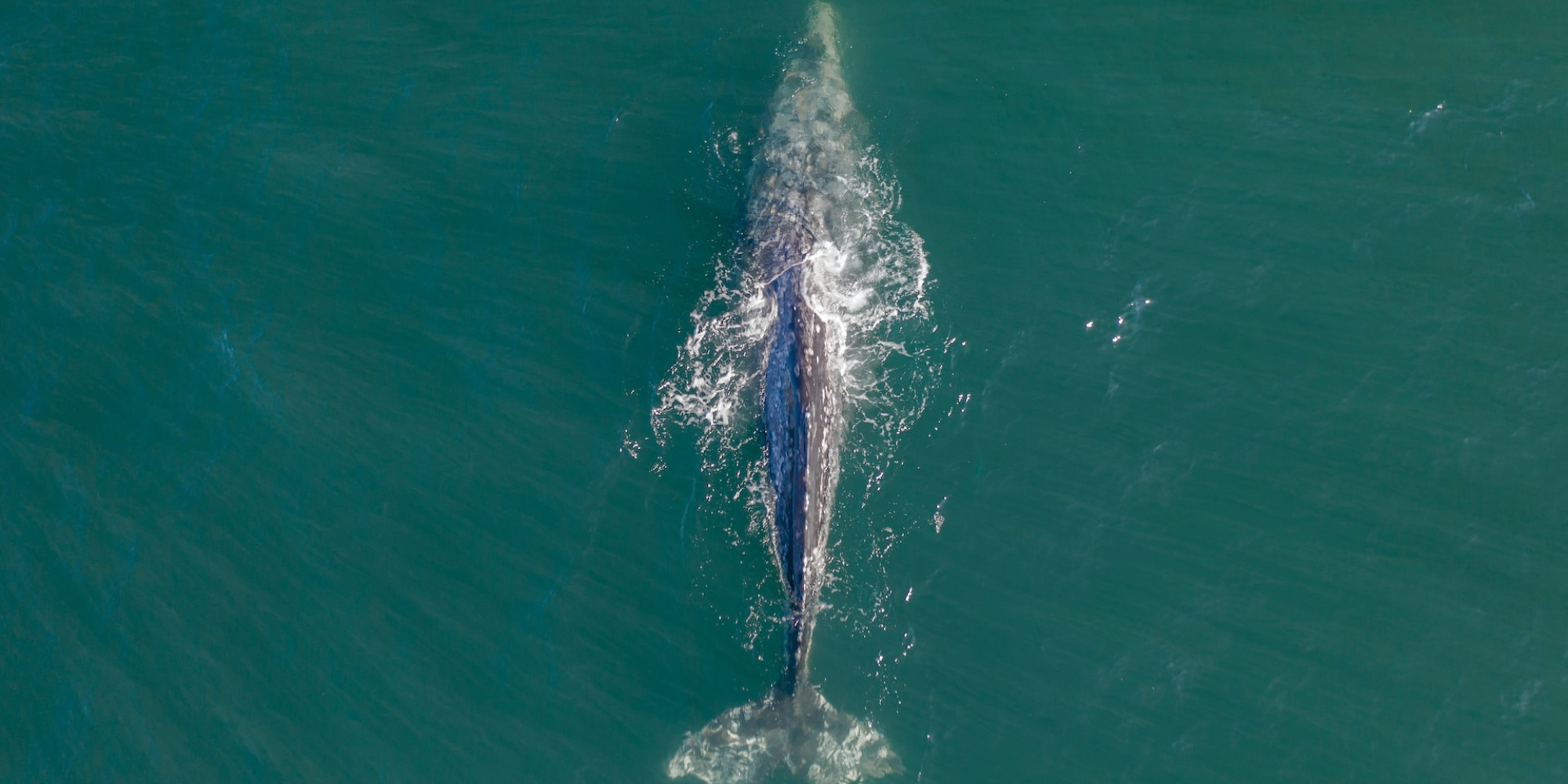
Why did we choose to feature this book in our WeWhale blog?
Well, Doreen Cunningham not only addresses the most critical issues of climate change, which we also want to address, but she also makes a very strong case for ocean noise pollution and what it means for whales and dolphins.
WeWhale is dedicated to solving this very problem by offering quiet, emission-free and respectful trips to see the marine mammals.
In this way, we ensure that parents can continue to take their children on a journey of discovery to these unique creatures without a guilty conscience or undue stress to the animals.
Our dream is to equip as many whale-watching sites as possible with our technology, so that perhaps one day we will be able to accompany the grey whales on their journey along the American West Coast.
The Strait of Gibraltar as a habitat
The Strait of Gibraltar is one of the most extraordinary habitats for fish and marine mammals in the world. It connects the Atlantic Ocean with the European Mediterranean Sea and separates the two continents of Europe and Africa, more precisely it separates Spain and Morocco.
At its narrowest point, it is only 13 kilometres wide and has a length of 58 kilometres. Due to its unique connection to European coasts, it is one of the busiest waterways in the world.
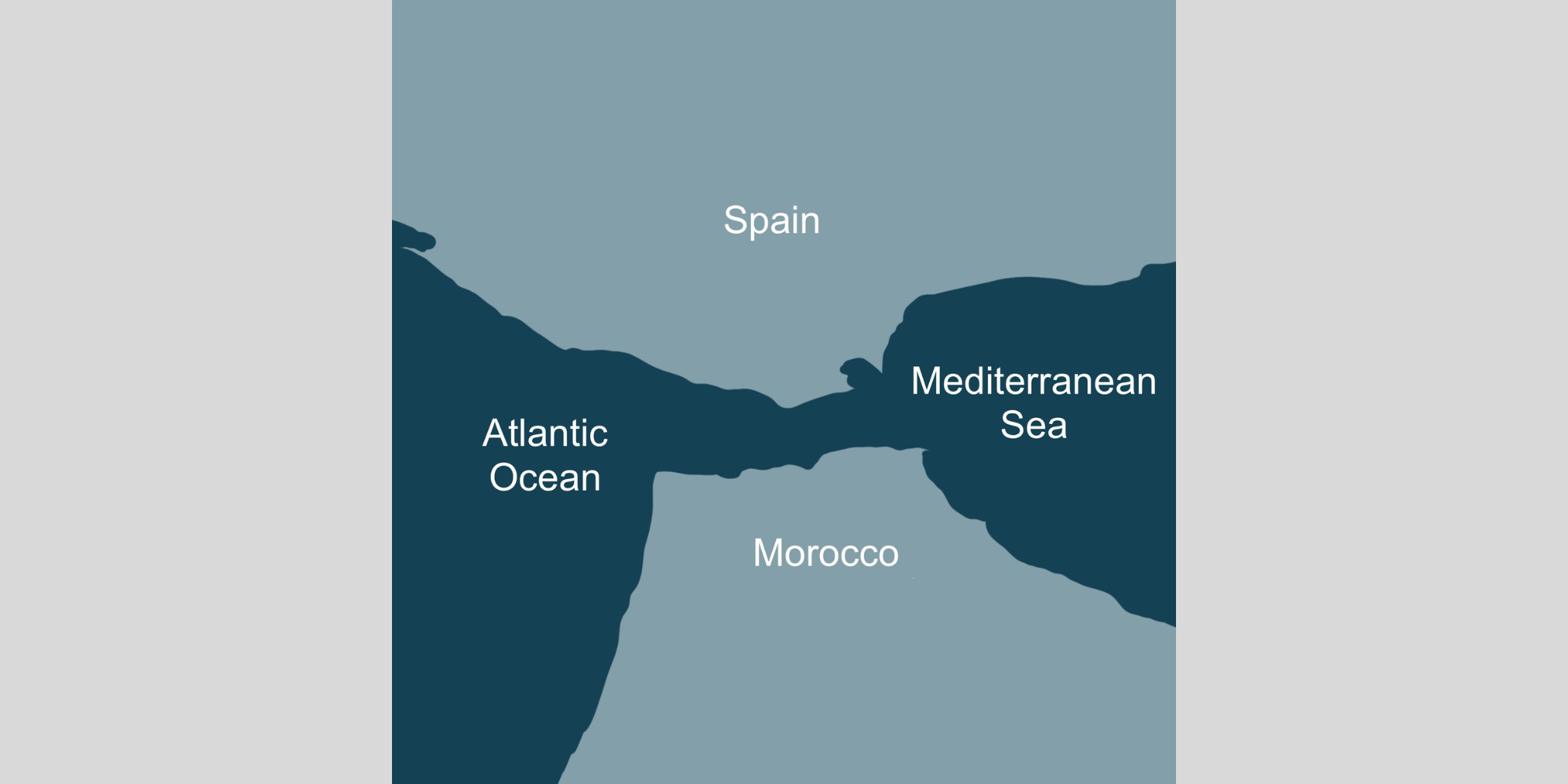
What makes the Strait special?
The Strait is also exceptional because of its underwater mountain range, which is on average 350 metres below sea level, but also has abysses up to 1,500 metres. From a geological point of view, this connection between the Mediterranean Sea and the Atlantic Ocean is also called the Gibraltar Threshold.
Every second, more than one million cubic metres of water flow from the Atlantic Ocean through the strait into the Mediterranean Sea. Slightly less flows back from the Mediterranean into the Atlantic.
The flow into the Mediterranean Sea is its only water supply except for access to the Red Sea via the Nile.
The Mediterranean Sea itself has very high evaporation, about 1-1.4 metres per year. If there were no compensation by the strong surface flow of the Atlantic, the Mediterranean would dry up within the next 2,000 years.
Due to the high evaporation, the water in the Mediterranean Sea is significantly saltier and therefore heavier.
When it flows back into the Atlantic, it sinks and moves as a deep current through the strait, along the underwater mountains. The resulting opposing currents bounce against the underwater mountains, creating turbulence that in turn stirs up nutrients from the ocean floor.
Rich habitat for plants and wildlife
These nutrients are what make the Strait of Gibraltar such a diverse habitat for plants and wildlife. They feed the phytoplankton population, which is so vast in the strait that it can even be viewed from space.
The phytoplankton in turn serves as a food source for the zooplankton, which serves as a nutrient for fish, and the fish populations in the Strait of Gibraltar feed the dolphins and whales.
This large food supply, which is naturally maintained by the opposing currents, ensures that whales and dolphins stay in the Strait of Gibraltar despite the high noise levels.
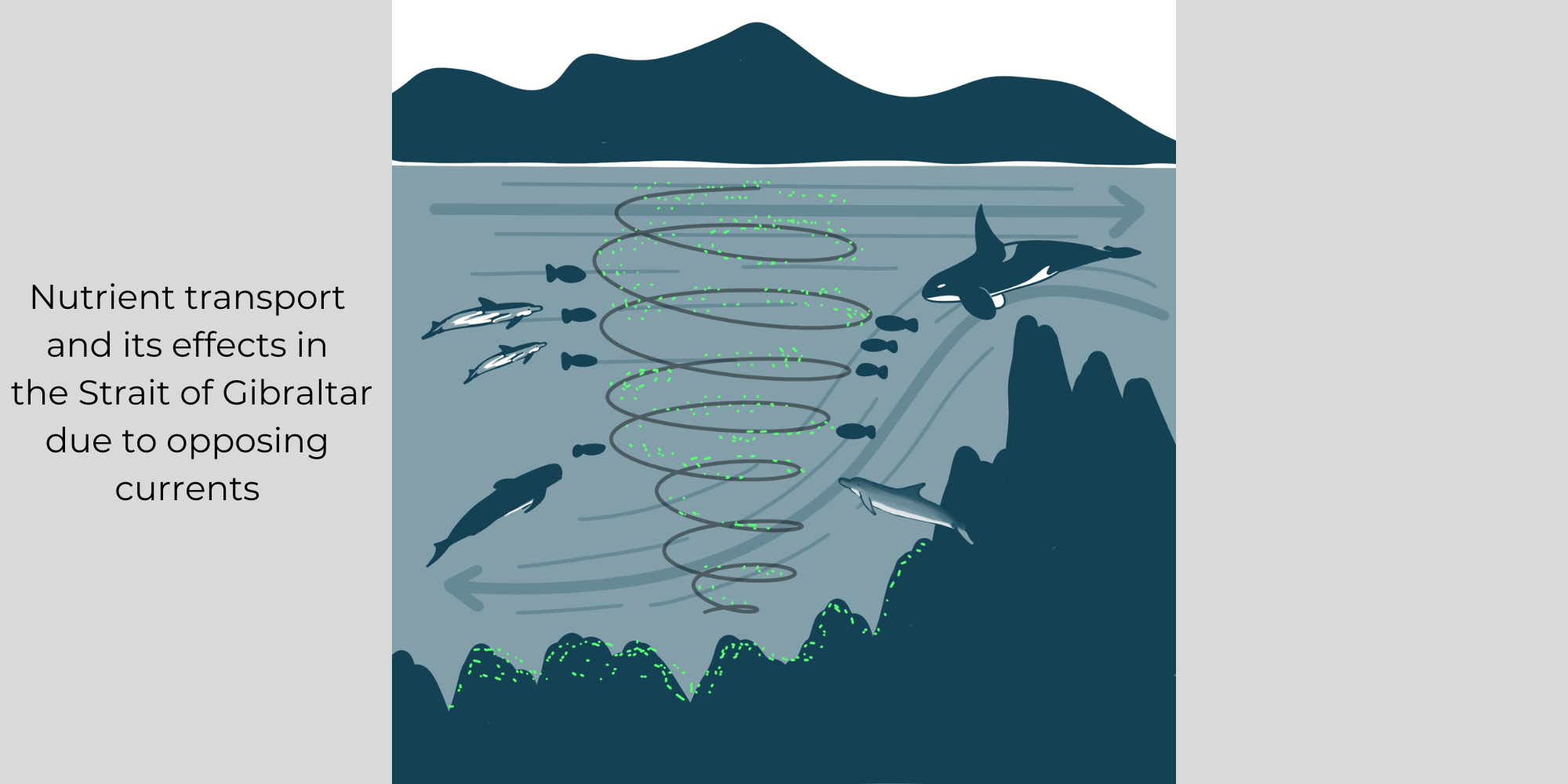
Whales present in the Strait
In addition, animals often migrate from the Atlantic Ocean to the Mediterranean Sea through the Strait in order to reproduce in a protected environment.
This is true, for example, of the fin whale (Lat. Balaenoptera physalus), but also of the tuna, which swims to the Mediterranean in early summer to lay eggs. Tuna is fished both when migrating into and out of the Mediterranean, and the latter in particular is heavily controlled to maintain tuna populations.
The fishing of the tuna also attracts a resident group of orcas (Lat. Orcinus orca) during the summer months between June and August, which take advantage of the fishermen’s fishing techniques and eat the tuna directly from the hooks.
The relationship between the animals and the fishermen is correspondingly tense and, depending on the yield of the catch, also repeatedly leads to violent outrage of fishermen.
Sperm whales (Lat. Physeter macrocephalus) are also native to the Strait of Gibraltar and the Mediterranean Sea. The resident animals use the depths of the strait to dive for giant squid and calamari.
Because sperm whales are toothed whales and, unlike baleen whales, actively snatch at their prey, they are at the mercy of the heavy plastic pollution in the Strait of Gibraltar.
Accordingly, plastic residues are increasingly found in the stomachs of the animals, which can be traced back to the inadequate infrastructure for waste collection and disposal on the coasts of the Strait.
In addition to fin whales, orcas and sperm whales, pilot whales are also at home in the Strait of Gibraltar. The common pilot whale (Lat. Globicephala melas) or pilot whale is often found in the Strait of Gibraltar. It is a medium-sized toothed whale that can grow between four and six metres long and weigh 1.8 to 3.5 tonnes.
Pilot whales have an estimated life expectancy of 60 years, also feed on squid and fish, and like bottlenose dolphins, can reach speeds of up to 35 km/h. On rare occasions, mixed schools of pilot whales and bottlenose dolphins (Lat. Tursiops truncatus) are seen hunting together in the Strait of Gibraltar.
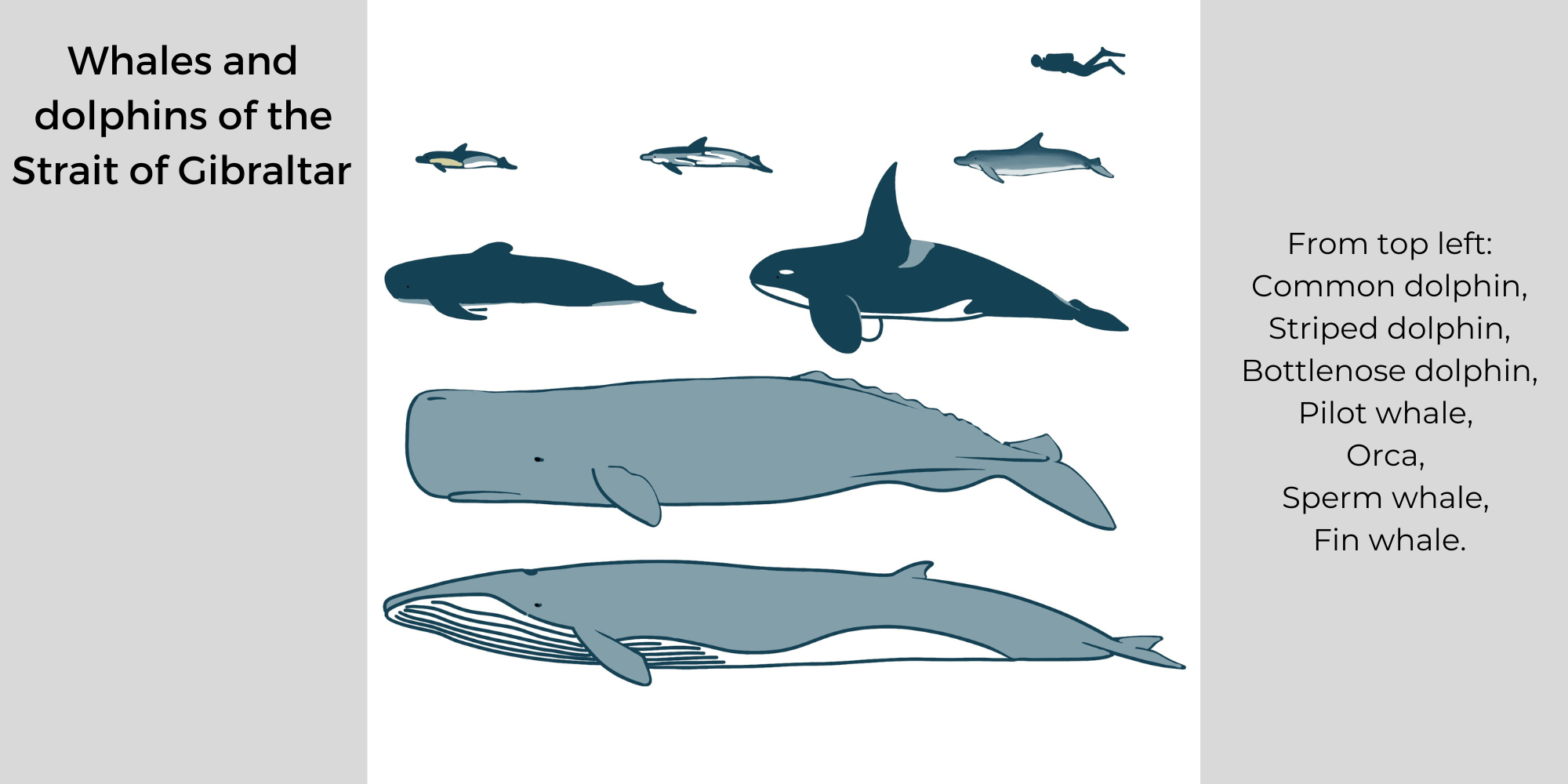
Dolphins present in the Strait
The bottlenose dolphin, one of the best-known dolphin species through movies such as “Flipper” but also through dolphinaria, can grow between two and four metres long, reaching a body weight of up to 650 kg.
Its life expectancy is similar to that of striped dolphins at about 50 years and they feed like the common dolphin mainly on fish and squid, where they can eat up to 36 kg per day.
In the wild, bottlenose dolphins can reach a speed of 35 km/h and dive for up to 20 min. Bottlenose dolphins can travel about 150 km per day.
The smallest dolphin in the Strait of Gibraltar is the so-called common dolphin (Lat. Delphinus Delphis). In total, common dolphins can grow between 1.7 and 2.4 metres long, reaching a weight of up to 130 kg.
The life expectancy of the animals is up to 40 years. In the Strait of Gibraltar, common dolphins are often found in mixed schools with striped dolphins.
As the name suggests, common dolphins were originally very common. Especially in the Mediterranean Sea they are now highly endangered, which is due to intensive human use in shipping, sewage and fishing or restriction of their food sources in coastal regions.
However, mothers and young common dolphins in particular prefer nearshore waters, as they offer some protection from sharks and other predators, which makes them even more vulnerable to pollution.
Finally, there is the striped dolphin (Lat. Stenella coeruleoalba). It is also known as the blue and white dolphin and, unlike the common dolphin, is still quite abundant in the Strait of Gibraltar.
It can weigh up to 150 kg and can reach a length of up to 2.5 metres. Its life expectancy is about 50 years.
Similar to the common dolphin, striped dolphins feed on fish and squid, but also eat crustaceans. The average daily food intake of a striped dolphin is 10 to 15 kg.
Summary
- The Strait of Gibraltar as a unique, nutrient-rich habitat for large fish populations (e.g., tuna), plant life, and resident whales and dolphins, despite the high volume of shipping traffic
- Special features: opposing currents from the Mediterranean and Atlantic Oceans and deep-sea mountains cause nutrients to be stirred up from the bottom of the Strait
- The whales and dolphins in the Strait of Gibraltar: the common dolphin, the striped dolphin, the bottlenose dolphin, the pilot whale, the orca, the sperm whale and the fin whale
What can we do?
- Raise awareness about the Strait of Gibraltar as a special habitat due to its geographic features
- Reduction of shipping and the associated noise pollution in the strait
- Limitation of fishing of the populations in the Strait of Gibraltar
- Protection of the resident species both from the plant, algae and animal kingdom
How do whales and dolphins help to protect the climate?
In the wake of looming threats posed by climate change, various studies are drawing attention to the great added value of marine mammals in terms of climate protection. These show, for example, that whales and dolphins, as well as other marine creatures, make an important contribution to the long-term storage of carbon in the deep sea and to stimulating CO2 uptake from the atmosphere.
Carbon stores in cetaceans
During the lifespan of any marine inhabitant, carbon is stored as one of the main components of the body’s cells. Since whales (and dolphins) are among the largest living creatures in the world, with life spans ranging from several decades to a century, the biomass of these sea creatures alone stores vast amounts of carbon that have been removed from the global carbon cycle.
It’s estimated that the removal of large parts of the whale population during the industrial whaling era transferred approximately 23.5 million tons of carbon from the oceans to the atmosphere. This corresponds to about half of the CO2 emissions in Germany due to industrial processes in 2021.
Today, the biomass of the global marine mammal population is about 76% less than before industrial whaling began . This effect has probably been further exacerbated by the fact that the largest whales in particular have been hunted, reducing the average size of different whale populations. Restoring the blue whale population in the Southern Hemisphere alone would store as much carbon in its biomass as a forest the size of Los Angeles.
Supporting the conservation and population building of fin whales, sperm whales, pilot whales, orcas and dolphins (such as bottlenose dolphins and also smaller marine mammals such as the common dolphin which lives in large schools), would drastically reduce the global CO2 budget.
This, in turn, would have a positive effect on climate protection, stop ocean acidification and warming, a circumstance that is especially hard on marine mammals but also on other marine life.
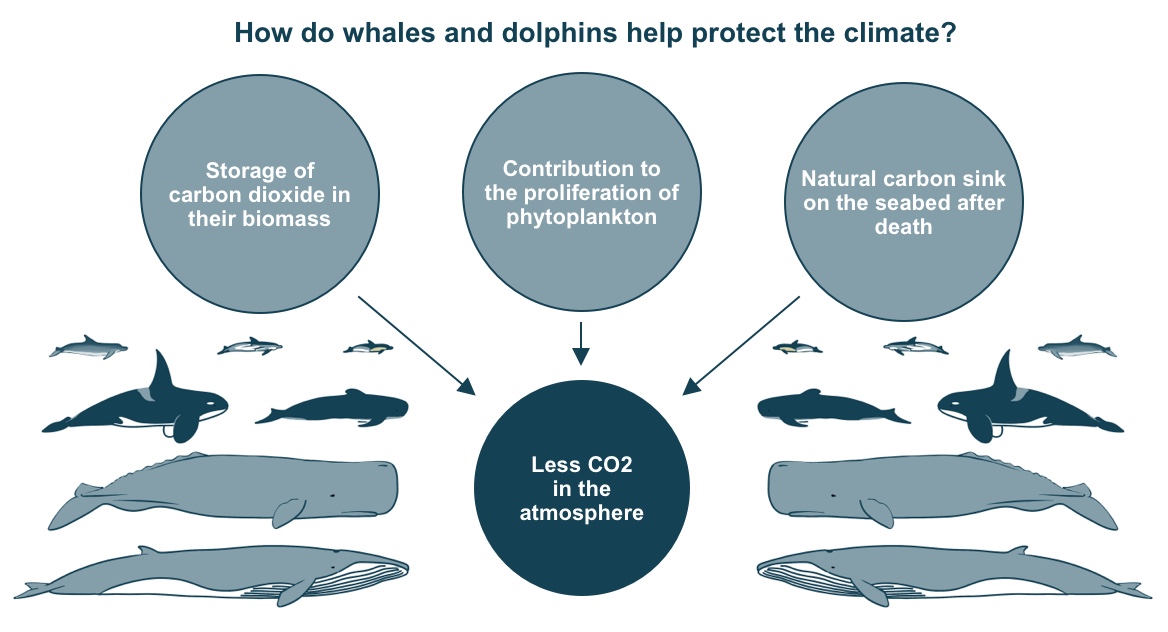
CO2 and phytoplankton
In addition, marine mammals contribute to the proliferation of phytoplankton through their way of life. In the oceans, phytoplankton not only serves as an important food source for zooplankton and thus also for fish, it also binds large quantities of CO2 from the air at the sea surface as part of photosynthesis.
The migration of large marine mammals, especially baleen whales, transports nutrients via their excretions from nutrient-rich feeding grounds to the often nutrient-poorer reproduction areas of the animals.
There, these in turn stimulate the growth of phytoplankton and thus the development of nutrients, habitats but also CO2 sequestration.
In addition, research shows that sperm whales bring large amounts of iron near the surface through their excretions. In areas such as the South Pacific, where plankton growth is limited due to iron deficiency, this leads to an increase in the plankton population, which benefits the entire ecosystem.
Plankton, in turn, according to the German Marine Foundation and Statista, represents about 98% of the global biomass in the ocean and is thus also one of the main drivers to sequester CO2.
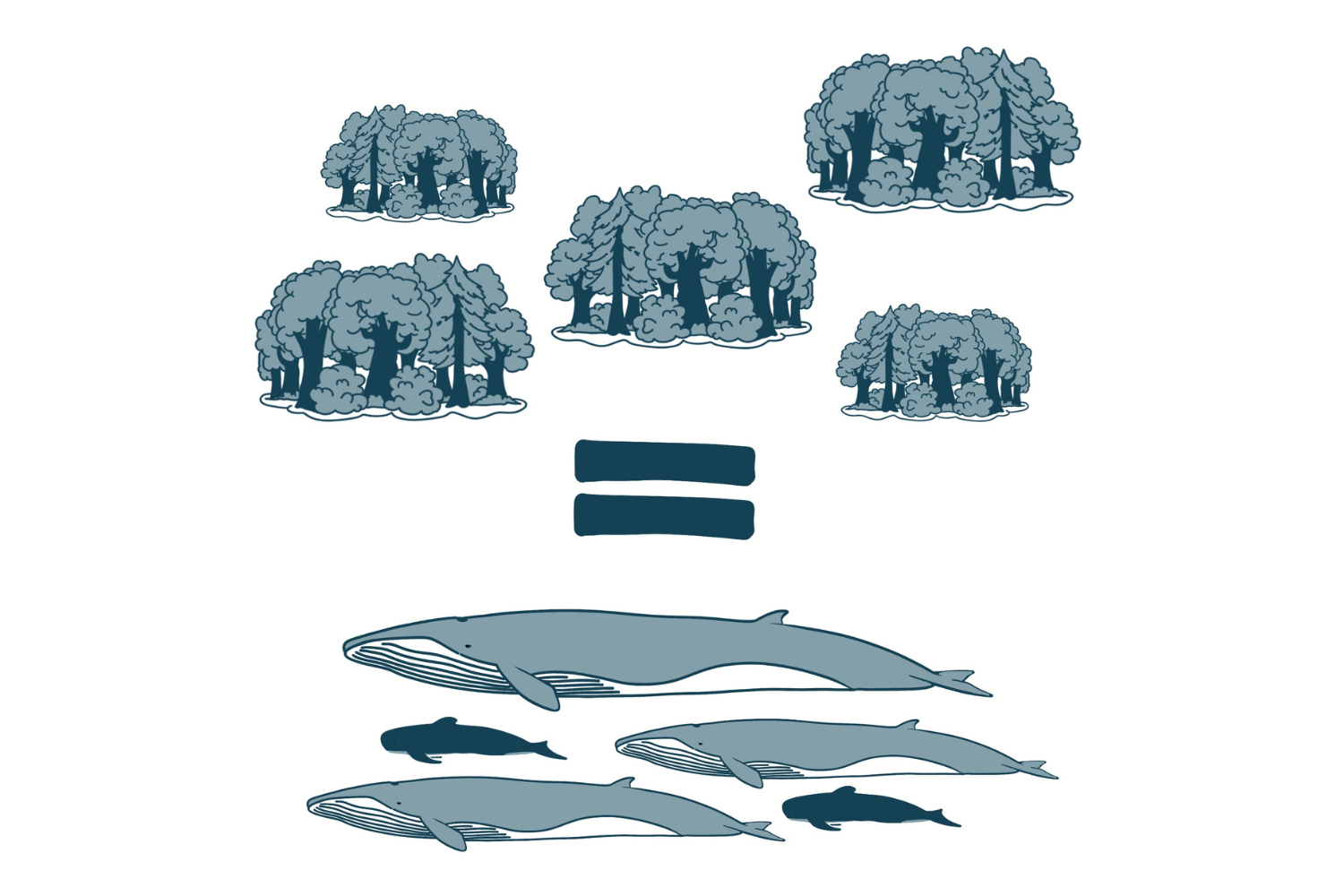
Carbon after a whale’s death
Provided that marine mammals eventually die a natural death at an advanced age, they sink to the bottom of the deep sea after their demise, where their carcasses sustain entire ecosystems of deep-sea organisms and form their own biotopes.
The carbon sequestered in the whale’s body is thus also stored on the seafloor for many millions of years and makes an important contribution to the balanced CO2 budget on our planet as a natural carbon sink.
Unfortunately, not all animals die a natural death. To the extent that animals are hunted, injured or killed by overfishing and increasing maritime traffic, or even taken into captivity for human amusement, they cannot fulfil their end-of-life role in protecting our planet.
Even whales that become stranded due to noise or plastic pollution and die on land cannot sustainably remove amounts of carbon from the CO2 cycle.
How can we help?
- Support the rebuilding of whale and dolphin populations on a global scale
- Reduce the number of whales and dolphins in captivity
- Curb global legal and illegal whaling
- Raise global awareness of the climatic added value of whales and dolphins
- Protect the migration of whales and dolphins to distribute nutrients e.g. phytoplankton
- Reduce noise pollution to prevent disorientation, loss of communication and stranding of animals
- Free whales and dolphins from “ghost” nets and other man-made debris to prevent disorientation and stranding of animals
- Reduce diesel and gasoline engines from ships and boats for cleaner oceans


